Tamiya 1/48 Mosquito B. Mk. IV, Srs ii (Modified)
The Mosquito bomber was the original purpose of the D.H.98 design. RAF authorities were doubtful of its ability to operate without defensive armament, depending on its speed to outrun enemy interceptors. The bomber version was only ordered into production following the success of the design in the photo reconnaissance role and as a long range fighter. The bomber was only ordered into production following the proof that the design functioned as promised from the tests of the prototype W4050, and after personal lobbying by Geoffrey deHavilland.
The Blenheim-equipped 105 Squadron in 2 Group was the first to convert to the Mosquito bomber when Geoffrey deHavilland jr. delivered the first one on November 15, 1941. W4066, the first B. Mk. IV Srs ii was formally accepted on November 17. By December, 105 Squadron moved to Horsham St. Faith outside Norwich. Deliveries of aircraft were slow, and the unit only had eight operational aircraft as of May 1942. The Mosquito bomber made its combat debut on May 31, in the wake of the first Thousand Bomber raid, when four Mosquitos bombed Cologne as the firefighters were attempting to extinguish the fires started the night before. Two of the Mosquitos were shot down by enemy AA. They then followed the second Thousand bomber raid on Essen the morning of June 2, and Bremen on June 26.
139 Squadron, the second equipped with the bomber, was formed on June 8. The two squadrons carried out their first combined operation on July2 when they bombed the U-boat yards at Flensburg. This was followed up over the rest of 1942 by increasingly-daring low-level daylight raids on enemy targets in Occupied Europe and Western Germany, led by the redoubtable Wing Commander Hughie Edwards, VC, who commanded 105 Squadron, which gained ample publicity. They bombed Berlin on the night of April 20/21. The last of the great low-level raids was flown against Jena on May 27, 1943.
Mosquitos became part of the Pathfinder Force when 109 Squadron joined the PFF on June 1, 1942. 109 was joined by 139 and 105 in the latter half of 1943. Later that year, 627 Squadron was formed and joined the Pathfinders, along with 692 Squadron. In April 1944, 627 became the Pathfinder squadron for the semi-independent 5 Group. During the course of these operations, 20 B. Mk. IV bombers had been modified with bulged bomb bays that allowed them to carry the 4,000-pound high explosive “Cookie” bomb, with their designation changed to B. Mk. IV srs ii (Modified).
Among the B.Mk.IV (Modified) Mosquitos was DZ633, which had flown an entire pathfinder tour with 692 Squadron before arriving at 627 Squadron on August 12, 1944. On August 31, the bomber was hit by flak over Rollencourt. Despite damage to the wings, the crew made it back to Woodhall Spa and the airplane was returned to DeHavilland for repair. Returning to the squadron two weeks later, she was hit in the right engine over Boulogne on September 17 on a photo-recon mission. The crew feathered the prop and returned to base. DZ633 then participated in the Oslo raid, where she was hit by flak, wounding the navigator, Flt. Lt. Wallace Gaunt, the only casualty of the mission. Repaired for a third time, DZ633 returned to operations in February and flew without harm for the rest of the war.
627 Squadron flew one of its most notable missions on December 31, 1944, to bomb the German Gestapo headquarters in Oslo. Taking off from Peterhead in northern Scotland, two six-plane flights of bombers flew across the North Sea at 28,000 feet to conserve gas. Over Oslo Fjord, they dropped to 3,000 feet and then went over the city at 1,000 feet before dropping from 500 feet. Smoke from the first bombs obscured the target so much that the second wave aborted their bomb run.
It was fortunate they did, because the first wave had missed the German HQ. While the RAF at first believed the raid was successful, it was later learned that the Victoria Terrasse building housing the Gestapo was undamaged. Instead, other civilian buildings had been hit and one bomb bounced off the ground and hit a crowded tram, killing 44 civilians. In total 78 Norwegians were killed and 27 Germans. It was the worst single incident in Oslo during the war.
627 Squadron operated B.Mk.IV (Modified) bombers, B.XX Canadian-built versions of the B. Mk.IV, and B. Mk. XVIs. DZ633 was one of the last B. Mk. IVs, which were not taken off service until after the end of the war.
THE KIT
The Mosquito bomber version was released by Tamiya in 1999. The kit differs from the other two in having the “bomber” nose and cockpit. Out of the box, it makes up into a standard B. Mk. IV Srs ii. Decals are provided for a day bomber from 105 squadron, a pathfinder from 109 squadron in night camouflage, and a P.R.IV from 541 Squadron of the Photo Reconnaissance Unit.
CONSTRUCTION
Having gotten well back into Mosquitos with the FB VI and NF XIII, I went searching on eBay and found a “factory fresh” B. Mk.IV that I won for $34.00, the original MSRP. Having also obtained an Airfix Mosquito P.R. XVI, I decided to see if the bulged bomb bay that was an option with that kit would fit the Tamiya kit. When I discovered it did, I decided to make a B.Mk.IV (Modified). I had decals for 627 Squadron from the Revell Mosquito kit.
A note right now: DO NOT WASTE YOUR TIME ON THE REVELL KIT. It bears little resemblance to an actual Mosquito, with an incorrectly-shaped vertical fin and rudder, main wheels too narrow and too tall, poorly-detailed landing gear, a mis-shaped canopy, and spinners that are bulbous. At best, the kit can be termed “Mosquito-ish.” If you want the Mosquito bomber, search out this Tamiya kit at a dealer's table at a show or among the many sellers on the internet. The difference between the two kits is night and day.
Again, I started by doing all the detail painting with the parts on the trees. The kit assembled as easily as the others, and the Airfix bomb bay fit like the proverbial glove once I cut off the attachment points for the Tamiya bomb bay doors.
COLORS & MARKINGS
DZ633 was in the “day” camouflage, which I did with Tamiya RAF Dark Green, Ocean Grey and Sea Grey Medium, after applying the D-Day recognition stripes to the lower rear fuselage and pre-shading the model. I sourced the serial number by piecing together decals from the three kits, while the national insignia and squadron ID (which was right for DZ633 from a photo) came from the Revell decal sheet.
Once that was done, I gave the model several coats of clear flat, then unmasked the clear parts, attached the props and landing gear, and applied exhaust staining with Tamiya “smoke.”
CONCLUSIONS
Most modelers think the “classic” B. MK.IV is the best-looking Mosquito and I agree. I wanted to do the Modified version because I've never had a model of that in my collection. After 20 years, Tamiya's Mosquitos are still the best in 1/48 and well worth the effort to track them down. They're easy models for anyone with some experience, and look great when finished. Highly recommended.
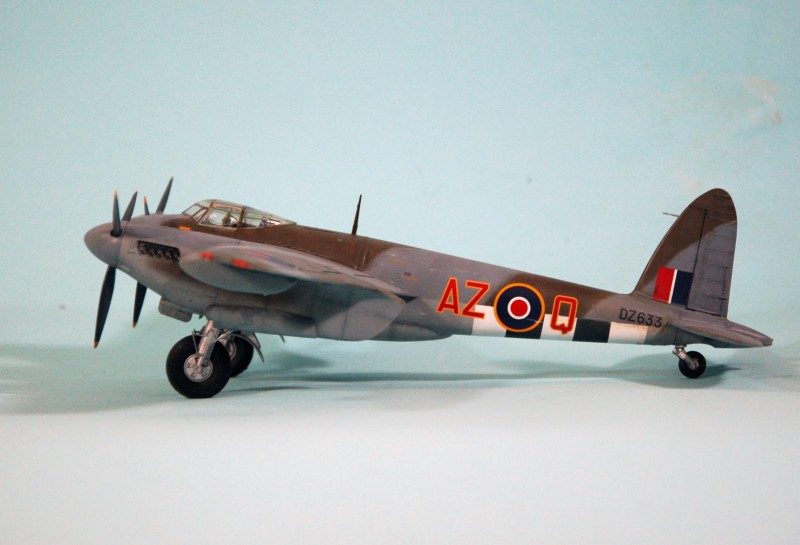
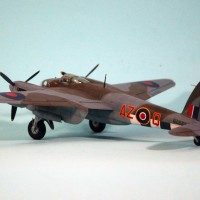

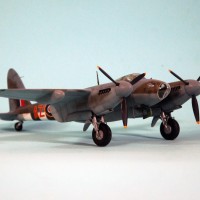

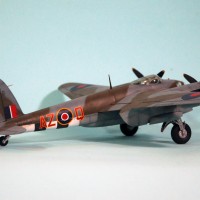
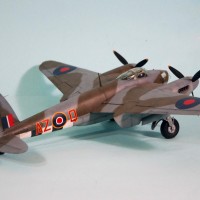
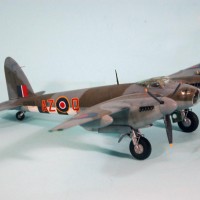
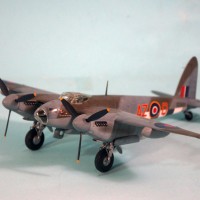
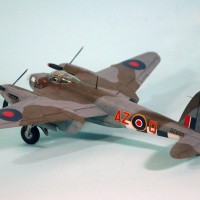
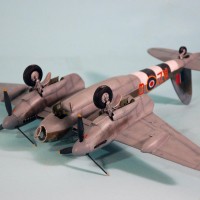

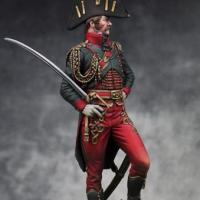
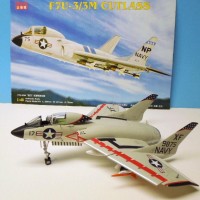
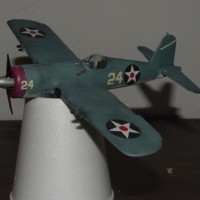
Nice all-around work as always, TC... 🙂
Nicely done, Tom!
Great job Tom!
That’s a beautifully done Mosquito.
Good to hear an objective take on the Aarhus raid.
‘Liked’
Yeah, nobody likes to mention that the Oslo raid and the Copenhagen raid weren't as successful as told at the time. Also the raid on Shell Haus in Rotterdam.
What's really interesting is to learn this year that the Amiens Prison raid was nothing like what 76 years of propaganda has led us to believe. The prison was for low-level non-violent French criminals only. There were no Resistance prisoners there and the Germans never came around the place, so no one was getting questioned under toture to give away secrets or get executed. It was all a big English fakakte based on false intelligence.
Handsome Mossie TC!
simply gorgeous
Beauty